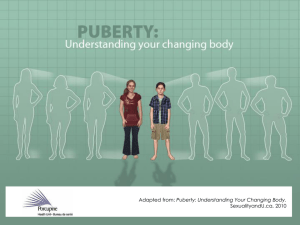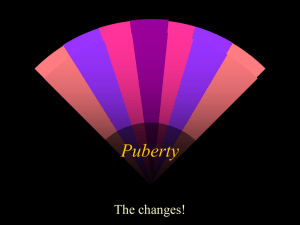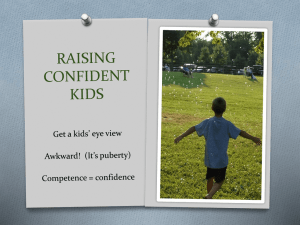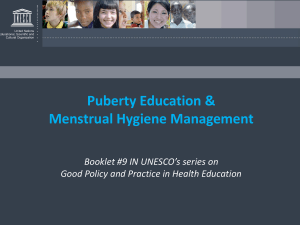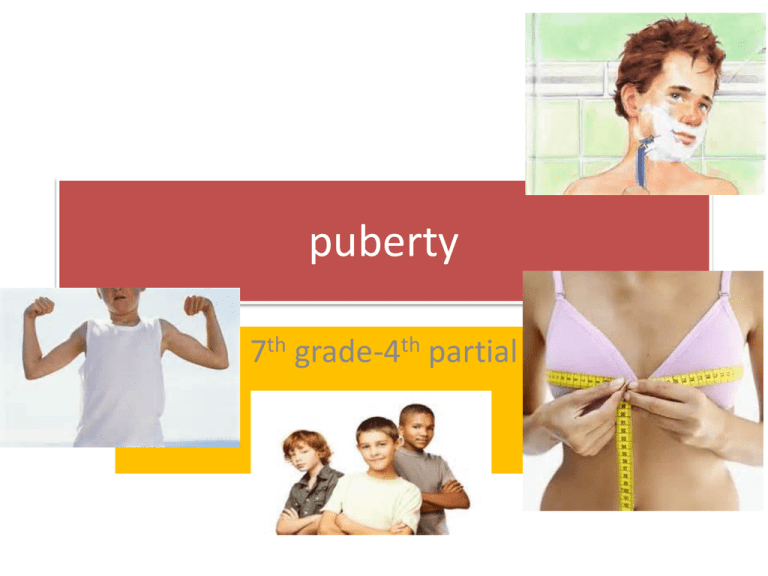
puberty
7th grade-4th partial
Puberty :process of physical changes by which a
child's body matures into an adult body capable of
sexual reproduction.
It is initiated by hormonal signals from the brain to the
gonads; the ovaries in a girl, the testes in a boy.
Responding the signals, the gonads produce hormones
that stimulate the growth, function, and
transformation of the brain, bones, muscle, blood,
skin, hair, breasts, and sexual organs.
Physical growth—height and weight—accelerates in
the first half of puberty and is completed when the
child has developed an adult body.
The age at which puberty begins varies between 10 and
13 years of age. Puberty age is affected by both genetic
factors and by environmental factors :nutritional state
and social circumstances.
• The major landmark of puberty for
males is the first ejaculation, which
occurs on average at age 13. For
females, it is menarche, the onset of
menstruation, which occurs between
ages 12 and 13.
• In the 21st century, the average age at
which children reach puberty is lower
compared to the 19th century, when it
was 15 for girls and 16 for boys. This is
possibly due to chemicals in food or a
better nutrition.
Testicular size, penis size, fertility
In boys, testicular enlargement is the first physical
manifestation of puberty (gonadarche) Testes in
prepubertal boys change little in size from about 1 year
of age to the onset of puberty. Size continues to
increase throughout puberty.
Two primary functions of testes:
1.Produce hormones
2.Produce sperm. During puberty,
a male's scrotum will enlarge and
begin to hang below the body as
opposed to being up tight.
Pubic hair
• Pubic hair often appears on a boy shortly after the genitalia begin
to grow. The pubic hairs are usually first visible at the base of the
penis
Body and facial hair
Following the appearance of pubic hair, other areas of skin that
respond to androgens may develop androgenic hair. The usual
sequence is: underarm (axillary) hair, perianal hair, upper lip hair,
sideburn hair, and the beard area. Arm, leg, chest, abdominal, and
back hair become heavier more gradually. Facial hair is often present
in late adolescence, but may not appear until significantly Chest hair
may appear during
puberty or years after. Not all
men have chest hair.
Voice change and Adam's apple
• Under the influence of androgens, the voice
box, or larynx, grows in both sexes. This
growth is far more prominent in boys, causing
the male voice to drop and deepen,
sometimes abruptly but rarely "over night,".
Before puberty, the larynx of boys and girls is
about equally small.
Male musculature and body shape
• By the end of puberty, adult men have heavier bones and
nearly twice as much skeletal muscle. Some of the bone
growth ( shoulder width and jaw) is disproportionately
greater, resulting in noticeably different male and female
skeletal shapes.
• This muscle develops mainly during the later stages of
puberty, and muscle growth can continue even after boys are
biologically adult. Often, the fat pads of the male breast tissue
and the male nipples will develop during puberty; sometimes,
especially in one breast.
• Body odor and acne
• Rising levels of androgens can change the
fatty acid composition of perspiration,
resulting in a more "adult" body odor. As in
girls, another androgen effect is increased
secretion of oil (sebum) from the skin and the
resultant variable amounts of acne.
Physical changes in girls
• Breast development
The first physical sign of puberty in girls is
breast development. Within six to 12 months,
the swelling has begun in both sides.
• Pubic hair
Pubic hair is often the second noticeable change
in puberty .In about 15% of girls, the earliest
pubic hair appears before breast development
begins.
Vagina, uterus, ovaries
• The mucosal surface of the vagina also
changes in response to increasing levels of
estrogen, becoming thicker and duller pink in
color .Whitish secretions are a normal effect of
estrogen as well. In the two years following
thelarche, the uterus, ovaries, and the follicles
in the ovaries increase in size.
Menstruation and fertility
The first menstrual bleeding is referred to as
menarche.The time between menstrual periods
(menses) is not always regular in the first two
years after menarche.
Body shape, fat distribution, and body
composition
During this period, also in response to rising
levels of estrogen, the lower half of the pelvis
and hips widen (providing a larger birth canal).
Fat tissue increases more than in males,
especially in the distribution
of breasts, hips, buttocks,
thighs, upper arms.
Body odor and acne
• Rising levels of androgens can change the
fatty acid composition of perspiration,
resulting in a more "adult" body odor. Another
androgen effect is increased secretion of oil
(sebum) from the skin. This change increases
the susceptibility to acne, a skin condition that
is characteristic of puberty. Acne varies greatly
in its severity.
Nutritional influence
• Nutritional factors are the strongest and most obvious
environmental factors affecting timing of puberty. Girls are
especially sensitive to nutritional regulation because they
must contribute all of the nutritional support to a growing
fetus.Excess calories (beyond growth and activity
requirements) are reflected in the amount of body fat, which
signals to the brain the availability of resources for initiation
of puberty and fertility.
Physical and mental illness
• Chronic diseases can delay puberty in both boys and girls.
Those that involve chronic inflammation or interfere with
nutrition have the strongest effect. In the western
world.Tuberculosis has been notorious for such an effect
in the last century, while in areas of the underdeveloped
world, chronic parasite infections are widespread.
• Mental illnesses occur in puberty. The brain undergoes
significant development by hormones which can
contribute to mood disorders such as major depressive
disorder, bipolar disorder, and
schizophrenia. Girls aged between
15 and 19 make up 40%
of anorexia nervosa cases.This is an eating
Disorder.
Questionaire
•
•
•
•
•
•
•
•
•
•
What is androgenic hair? Give examples.
How does facial hair change?
What are the two functions of testes?
What changes do boys experience during puberty?
Where does puberty start in boys and girls?
What are gonads?
What do they do?
Why can puberty begin at different ages?
What is menarche?
What are the physical changes in girls?
evaluation
•
•
•
•
•
Project I: 30pts.
Project II: 20 pts.
quiz: 10 pts.
Word document: 10 pts
Exam
30



